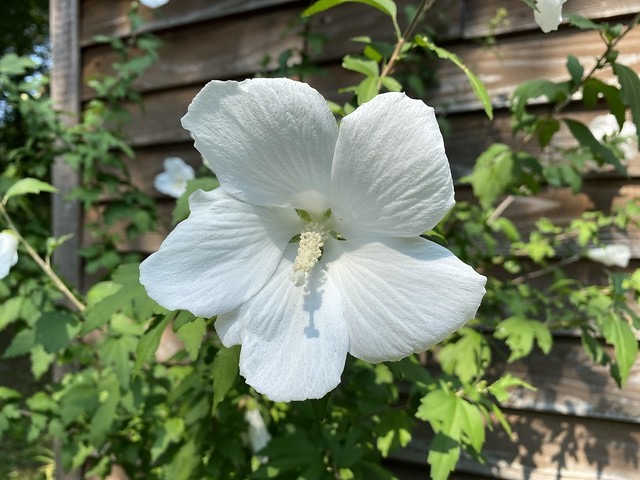
Rose of Sharon, West Central Arkansas, July 29, 2021 (iPhone 11)
Hibiscus syriacus1
A species of flowering plant in the mallow family, Malvaceae, Hibiscus syriacus is native to south-central and southeast China, but widely introduced elsewhere, including much of Asia. Common names include the mugunghwa (in South Korea), rose of Sharon (especially in North America), Syrian ketmia, shrub althea, rose mallow (in the United Kingdom).
Hibiscus syriacus is a hardy deciduous shrub. It is upright and vase-shaped, reaching 2–4 m (7–13 feet) in height, bearing large trumpet-shaped flowers with prominent yellow-tipped white stamens. The flowers are often pink in color, but can also be dark pink (almost purple), light pink or white. Individual flowers are short-lived, lasting only a day. However, numerous buds produced on the shrub’s new growth provide prolific flowering over a long summer blooming period.
Rose of Sharon2
Rose of Sharon is a common name that has been applied to several different species of flowering plants that are valued in different parts of the world. It is also a biblical expression, though the identity of the plant referred to is unclear and is disputed among biblical scholars. In neither case does it refer to actual roses, although one of the species it refers to in modern usage is a member of Rosaceae. The deciduous flowering shrub known as the rose of Sharon is a member of the mallow family which is distinct from the family Rosaceae. The name’s colloquial application has been used as an example of the lack of precision of common names, which can potentially cause confusion. “Rose of Sharon” has become a frequently used catch phrase in poetry and lyrics.
Varying scholars have suggested that the biblical “rose of Sharon” may be one of the following plants:
-
- A crocus: “a kind of crocus growing as a lily among the brambles” (“Sharon”, Harper’s Bible Dictionary) or a crocus that grows in the coastal plain of Sharon (New Oxford Annotated Bible);
- A tulip: “a bright red tulip-like flower … today prolific in the hills of Sharon” (“rose”, Harper’s Bible Dictionary);
- Tulipa agenensis, the Sharon tulip, a species of tulip suggested by a few botanists or
- Tulipa montana
- A lily: Lilium candidum, more commonly known as the Madonna lily, a species of lily suggested by some botanists, though likely in reference to the lilies of the valley mentioned in the second part of Song of Solomon 2:1.
- Narcissus (“rose”, Cyclopaedia of Biblical, Theological and Ecclesiastical Literature)
A rose is a rose is a rose3
The title for this post occurred to me as a takeoff on the phrase “Rose is a rose is a rose is a rose.”
Of course, I had to research the phrase …and down the rabbit hole I went.
I learned that it was from a 1913 poem, Sacred Emily, by Gertrude Stein, which I ended up adding as a post on my rarely updated A Selection of Poetry blog.
Sacred Emily is a long abstract poem, probably most famous for the phrase “A rose is a rose is a rose.” Some believe the poem to be a dedication by Gertrude Stein to her life partner, Alice B. Toklas.
- “Hibiscus Syriacus.” Wikipedia. last edited August 3, 2021. Accessed August 6, 2021. https://en.wikipedia.org/wiki/Hibiscus_syriacus.
- “Rose of Sharon.” Wikipedia. last edited, July 28, 2021. Accessed August 6, 2021. https://en.wikipedia.org/wiki/Rose_of_Sharon.
- “Rose Is a Rose Is a Rose Is a Rose.” Wikipedia. last edited, June 22, 2021. Accessed August 6, 2021. https://en.wikipedia.org/wiki/Rose_is_a_rose_is_a_rose_is_a_rose.

